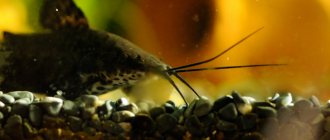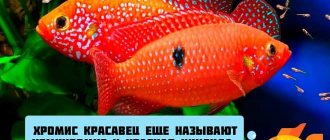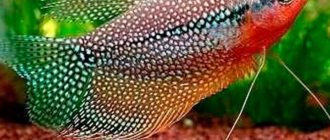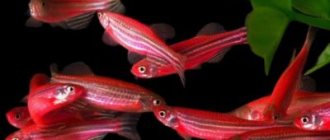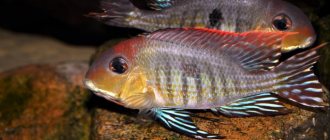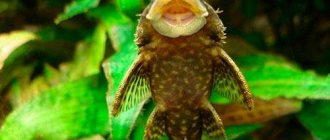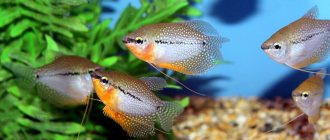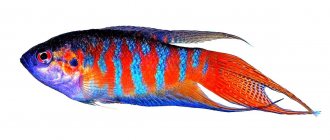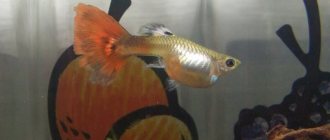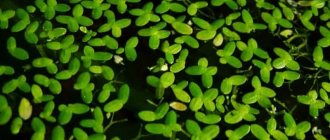Habitat and origin
Pseudotropheus demasoni is an aquarium fish from the order of dwarf cichlids of the Mbuna group (“stone fish” in the language of Malaysian fishermen). This species appeared in aquarium culture relatively recently. Habitat: African Lake Malawi.
The optimal living conditions for pseudotropheus are the rocky shores of Lake Pombo (Tanzania). The habitat also determined the diet of the fish. The hydrobiont feeds on algae growing on the rocks of the lake, larvae of small insects and mollusks.
Description
- Body shape: torpedo-shaped.
- Dimensions: 6.5-7.5 cm in length.
- Color: can vary depending on the sex of the fish and its species.
- Life expectancy : about 10 years.
Important! Pseudotropheus will feel comfortable in an aquarium if there are at least three females for each male.
Also important for these fish is the presence of personal space: a cave, grotto or masonry.
Types of colors
Bright and unusual colors are the calling card of these fish. It is difficult to find two identical predotropheus even within the same species.
Zebra
Pseudotropheus of this color are quite polymorphic and can have up to 50 color options. The most common forms: white, blue, red female and male, yellow-orange with black-brown spots. The length of the zebra pseudotropheus can reach 15 centimeters. Females can be plain or spotted.
Zebras are aggressive, so it is better to keep them in the same aquarium with fish of the same species. The number of females should exceed the number of males. A clear hierarchy has been established between males. The pseudotropheus zebra spends most of its time in the lower layers of water.
We recommend that you read about how to breed and keep plants such as Marsilia, Sagittaria, Pogostemon, Hornwort, Java moss, Cryptocoryne and Hemianthus micranthemoides in an aquarium.
Brown (fuscoides)
The size of these fish is slightly smaller than the zebra pseudotropheus, but the color options are no less varied. Fuscoides can be lilac-beige, lemon, dark brown and yellow. Brown pseudotropheus also boasts the presence of spots and yellow or chocolate stripes on the body.
Agate
Males of this species have a noble blue-black color and a yellow-green border on the fins. Females are distinguished by more complex patterns with crosses, strokes and sparkles. The fry have a dirty yellow tint.
Sokolofa
The fish is medium in size, but incredibly bright blue in color. Cichlids of this species get along well in a large group. They are non-conflicting, but very timid. When frightened, this pseudotropheus becomes covered with purple spots. Therefore, it is important that the aquarium has a sufficient number of hiding places where the fish can hide.
You will probably be interested in reading about how to start an aquarium for the first time, where to start a saltwater aquarium, what types of aquarium algae there are and how to deal with them.
Lombardo
Both the male and female of this species are striped: the male is yellow, the female is blue. They look very harmonious together. The male Lombardo has a violent temperament.
When caring for an aquarium, artificial conditioners such as “Methylene Blue” and “Malachite Green” are used, as well as the disinfectant “Sidex”.
Livingstony
The smallest cichlids, measuring no more than 10 cm. Males are larger than females. They have a dim gray-yellow or yellow-blue color. Their small bodies have minimal decoration: a black or white border on the fins of the male.
Malawi 6
Definitely, this is the most popular species in the post-Soviet space. These six-centimeter fish (that's what the number 6 in the name means) are adored by many aquarists for their variegated striped color: a blue background is crossed by bright stripes of black or blue-purple.
In addition to their external beauty, these fish are quite friendly and can be kept in large schools in public aquariums.
Did you know? The smallest fish in the world is Schindleria prematurus. Its weight is only 2 grams.
Types of pseudotropheus
Pseudotropheus Demassoni
The male’s body is covered with bright transverse stripes with clear contours in dark blue, black and light blue. They are also present on the head, however, they do not extend onto the fins. The dorsal, anal and other fins are dark blue, with black and white edges. It is better to keep them in flocks of 10-15 pieces, of which 3-4 may be males. Pair keeping, as well as two males in one aquarium, is not recommended. Either one or many. This is a zebra type cichlid that is part of the Mbunas group.
There are 13 clans full of very active and aggressive personalities of the Mbuna Tsibuls. The name Mbuna comes from the Tongan people of Malawi and means "flounder" or "rock dwelling". This name accurately describes the environment in which these fish live, rather than being open water swimmers such as Utaka cichlids and other "spots". Regardless of the size of the aquarium, they should be kept in a group of twelve or more people. To help disperse aggressive behavior. This helps keep the dominant man from harassing women and others through constant harassment by spreading "love". Make sure the aquarium has extensive rock formations that provide plenty of hiding places. As this will also help prevent violent aggression between them. Piles of rocks can be arranged to create multiple caves and passages.
Pseudotropheus zebra
This species has about 50 color morphs. It has a peaceful nature and can be kept in flocks. Males have pointed dorsal and caudal fins. And females have a rounded dorsal and caudal fin. Prefers a spacious, well-filtered tank with rocky decoration. Rocks arranged to form small caves are suitable for this species. But it also requires small areas of open water. A sandy substrate is recommended. Best supplied high quality Cichlid pellets designed for herbivorous African Cichlids. As well as brine shrimp, mosquito larvae and algae vases. It will also benefit greatly from feeding mostly vegetable foods. Such as spirulina flakes or blanched spinach.
Pseudotropheus elongatus (slender)
It has a slightly more elongated and thin body compared to its relatives, which is why it got its name. In coloring it resembles Demassoni, but the colors are paler. There is a morph with a yellow tail. A very restless fish, keeping it in a species aquarium is recommended. Adults reach an impressive length of up to 16 cm. Hatchlings consist of 24-30 fry. Which quickly turn blue and black (i.e. usually within 2 months). And like most mbuna, this species is mostly vegetarian. It should be fed foods high in spirulina and other plant substances. This applies to the overall length (including the tail) of typical aquarium specimens. Wild specimens may not reach this size. Or may actually grow larger than the tank raised by the individual due to various factors. Also note that this is a typical maximum size, and there are exceptional ones that will exceed it.
Pseudotropheus Aki (Acey, purple)
A fairly unpretentious herbivorous fish, easy to keep even for beginners. It has a discreet but pleasant color: lilac with yellow fins. There are dark blue morphs with yellow or white fins.
The fish is peaceful and does not show territorial claims in natural conditions. But in an aquarium in a confined space it can behave aggressively. Aki, like most mbuns, has a very long intestine. Therefore, they can live with a few algae bites a day. These fish are at high risk of Malawi bloat. The protozoa alternate so much that they cause blockages in the intestines. Therefore, neither food nor gases can pass, causing them to swell. The bloat eventually damages their liver, bladder and kidneys so badly that they die within 24-78 hours. Aki has bicuspid teeth similar to the rest of the genus Pseudotropheus.
Pseudotropheus pindani (Sokolofa, Sokolova)
It has two morphs: completely blue, and blue with blue fins. The content is harem. Vegetable feed with small animal admixtures. You can give frozen krill, pieces of squid and frozen cyclops. They love vegetable salads: zucchini, nettle, dandelion. Of course, all this should not linger in the aquarium after the end of the meal.
Individuals from Cobue & Mbweca lack the subarginal black stripe on the dorsal fin. Those from Mara Point & Tumbi Point have a subgarginal black stripe. It is weakly territorial in the aquarium. This is one of the easiest types of mbuna for beginners. In the wild, it selects its food from short algae attached to rocks in the intermediate habitat. Females and males are identical, except for some females who sometimes lack egg spots. This measure is a relative value, comparing one species to all other cichlids. This only explains the focus in the aquarium, not breeding considerations. 1 = easy and forgiving, 5 = extremely difficult.
Pseudotropheus flavus
Lives off the coast of. Chinyankwazi. The species has a very pronounced territorial confrontation between spawning males. They are no less strict with their ladies. The aggression of males can be dissipated by gathering a large school (10-12 fish) in the aquarium and placing more shelters. Plants don't survive. Males are very brightly colored: frequent yellow stripes run along the brown background of the body. With age they almost merge. Females look modest.
Pseudotropheus flavus was originally classified as elongatus sp. "dinghani". But upon further study of its morphology and habitat, it was suggested that this fish is indeed a separate species. Consequently, it received its own species classification. Despite this, flavus is still considered a member of the Pseudotropheus elongatus complex. The males of this rare species are very bright. But women tend to be a hazy mixture of shaded yellows and browns. This mbuna also becomes long and slender.
In the wild, it usually grows to a maximum female Pseudotropheus flavus of 3 inches (8 cm) in length. And males are slightly larger than females. Due to their smaller size, they have been grouped among the pygmy dwarf species. In captivity, however, this fish can easily reach a maximum length of 4 or 5 inches (10-12.5 cm). In my experience, they begin to show their adult coloration as early as 2 inches (5 cm) away. In the wild, Ps. flavus is found among the sedimentary rocks of the Chinyankwazi Island reef, at depths of 7 to 20 m. This mbuna is an omnivore, living mainly on plankton in open water and algae that grow on the rocks. For an aquarium, I recommend a spirulina pill.
Pseudotropheus minutus
A small cichlid up to 8 cm long. Reminds me of Demasoni, but the stripes are more pronounced closer to the head. And starting from the supposed center of the body they turn pale. They come onto the dorsal fin. The white edge of the dorsal fin is wide. Females are bluish. There is a morph with brown stripes on a pale yellow background, the saturation of which increases as it approaches the dorsal fin.
The typical locality of Chindongo minutus is Nkhata Bay. Located on the western shore of the lake in its northern region. The geographic limits of its range are not known with any precision, but they also occur north of Nkhata Bay in Lion's Bay. And further north at Ruarwe (reported male and female capture site in accompanying color photographs). Several similar, but perhaps particularly distinct, populations occur throughout the eastern shore of Lake Malawi, differing from those on the western shore primarily in details of coloration. None of these different east coast forms have been studied, described or named in detail until now.
Pseudotropheus Williams
A fish with an elongated body, beige or light yellow in color with black stripes, broken into separate spots. Looks like a wooden chessboard. A distinctive feature is protruding purple lips. The caudal fin has black rays. This applies to the overall length (including the tail) of typical aquarium specimens. Wild specimens may not reach this size or may actually grow larger than aquarium size caused by humans due to various factors. Also note that this is a typical maximum size and there are exceptional people who will exceed it.
Pseudotropheus longior
Beautiful fish with iridescent color. Color distribution on the body: belly and back - yellow, sides - purple or pinkish. The head is golden with purple sparkles. The fins are patterned, with blue and black veins along a yellow field. There are transverse stripes, but they are weakly expressed. In some males, the yellow color is replaced by dark gold or brown.
Pseudotropheus Saulosi
Difficult to distinguish from Demasoni. The color is about the same. Females are yellow. Subdominant males are grayish-pink. This species can reach a length of 8.6 cm (3.4 in). The fish are born yellow, but when they reach maturity, the males turn blue with several vertical black stripes. Less dominant males are paler blue, and some young males may remain mixed with females, wearing the typical yellow female dress. When a dominant male leaves a particular group, one of these incognito males may color and become dominant.
Pseudotropheus saulosi is the father's mouth. The female holds the eggs in her mouth until the fry are able to swim. It usually takes 13-18 days. The fish are vulnerable in the wild, and efforts are underway to repurpose a Taiwanese reef with faces devoid of anger
Pseudotropheus perspisax
The fish is very difficult to keep and is only accessible to experienced aquarists. The color of males is uniform: blue, lilac, violet. A bright orange or red stripe runs from the snout along the forehead to the dorsal fin. Then it fades and runs like a yellow edging along the caudal, anal, and ventral fins, as if completing a circle. The pectoral fins are transparent. Females are gray.
Pseudotrophus Lucerne
Pseudotropheus Lucerne is distinguished by its light color, on which transverse stripes are barely visible. The body of the fish is silver, the head and upper back are tinged with beige. The caudal fin is black with white rays. Some morphs are colored dirty blue instead of silver, and their stripes are more pronounced. Thanks to their bright colors, pseudotropheus quickly became a favorite of aquarists. This led to a sharp decline in their population in natural conditions. Therefore, everyone who today decides to devote themselves to keeping this fish bears the responsibility for preserving its gene pool. Many types of pseudotropheus in a limited aquarium volume are inclined to crossbreed. The resulting hybrids for the most part have no decorative value and are evolutionary garbage. Therefore, if you want to diversify the population of the aquarium, it is better to do this at the expense of cichlids of other species, rather than collecting a collection of pseudotropheus.
Maintenance and care
Before getting pseudotropheus, you need to stock up on sufficient theoretical knowledge about their content. These bright fish are demanding on water quality and are completely unfriendly to their aquarium neighbors if they have to coexist with representatives of another species.
In addition, cichlids love to have personal space and a place where they can always hide. It is extremely important to follow the correct diet for feeding the fish.
Aquarium
The main guideline when creating an aquarium for Mbuna cichlids is the size of the fish. For small representatives, no more than 6-10 cm in size, a 60-liter aquarium will be sufficient.
Medium-sized pseudotropheus will feel comfortable if the volume of water is at least 100 liters. If you plan to keep pseudotropheus in the same aquarium with other, larger species of cichlids, then you cannot do without a good-quality two-hundred-liter aquarium.
Mbuna cichlids are quite demanding on water quality. Its temperature should be in the range of 24...28 °C, acidity - 7.2-8.5, water hardness - 4-20. Owners of pseudotropheus should not forget about constant aeration and filtering of water.
A minimum of 30% of the total water volume must be replaced with fresh water weekly. To maintain the normal functioning of fish of this species, dim, weak light is sufficient. They do not require bright lighting, since they are accustomed to living in the lower layers of water.
Aquarium decorations
An aquarium for pseudotropheus should be decorated with a sandy substrate; large stones and rock fragments must be present.
It will be useful for you to read about what items are the most necessary for your aquarium.
Imitating the natural habitat of cichlids, grottoes and crevices should be formed from stones. All kinds of tubes and ceramic cups can provide shelter for timid fish.
Feeding
Feeding Mbuna cichlids should be approached extremely responsibly. Each species prefers to feed on certain foods, but in general, most of the diet of pseudotropheus consists of vegetation. This means that there should be enough of it in the aquarium.
The rest is live food and universal industrial mixtures. You should not overfeed these fish by introducing bloodworms, coretra or chopped tubifex into their diet. This can lead to obesity and death of the cichlid.
Important! Plants in a cichlid aquarium must have a strong root system so that active pseudotrophae cannot tear them out of the ground.
Reproduction and breeding
Reproduction of a significant part of cichlid species in an aquarium is not difficult. Moreover, spontaneous spawning in a community aquarium when standard comfortable conditions are created is not at all uncommon.
Sexual dimorphism is not pronounced in all species. Male cichlids are usually slimmer, larger and brighter than females, have more developed pointed fins, and may have a fatty tubercle on the head. The anal fin of the males of African species is often decorated with bright spots. You can unambiguously determine the sex by the genital papilla: in females it is pear-shaped, and in males it is awl-shaped. Sexual maturity occurs at 8-18 months. To stimulate spawning, it is necessary to make a partial replacement by adding softer water, raising the temperature by a few degrees, changing the light regime and increasing nutrition (a large amount of protein food).
Bright spots on the anal fin of Aulonocara are a sexual characteristic.
Editorial: Barbus black
The cichlid family is very heterogeneous in its methods of reproduction and mating displays.
Spawning on an open substrate is not uncommon among cichlids.
Five main groups of cichlids can be distinguished according to the type of spawning:
- Spawning in shelters (stone caves, flower pots, plastic tubes, etc.). This includes mainly small representatives of different genera: apistogramma, pelvicachromis, neolamprologus (lay eggs in empty shells of gastropods)
- Spawning on an open substrate (stone, leaf, aquarium wall, etc.). Similar behavior is typical for carnivores, astronotuses, angelfish, and discus fish.
- Oral incubation (full cycle of development in the oral cavity). This type of spawning is characteristic of endemics of lakes Malawi (Nyasa), Tanganyika and Victoria. It is primarily due to the fact that the surrounding rocky landscape of the lakes does not have suitable shelters.
- The eggs are laid on the substrate for a day or two and then hatched in the mouth; Species with a similar type of reproduction include representatives of the genera - bujurquins, gymnogeophages, and some species of geophages.
- In the genera Cyprichromis and Paracyprichromis, spawning occurs in the water column; females pick up each portion of eggs in flight and hide them in their mouths.
But whatever type of reproduction is inherent in each specific species, they are united by a highly developed parental instinct. Caring for the eggs and then the fry increases the fry's chances of survival.
Angelfish fry
Often stable pairs of complete families appear, in which both the female and the male care for the offspring. A typical example is discus and uaru - both parents are capable of secreting a skin secretion on which the fry feed.
Incubation of eggs in the mouth lasts 14-40 days, on the substrate - 2-4 days, and after 4-6 days the juveniles begin to move and feed independently.
Compatibility with neighbors in the aquarium
Pseudotropheus are extremely unfriendly and aggressive, which leaves little hope that they can get along in an aquarium with other fish. Cichlids protect their territory not only from strangers, but also from their own.
You can make cichlids less aggressive if you bring their living conditions as close as possible to natural ones. In addition, the aquarium should have enough water and places to hide, and the number of females should be three to four times greater than the number of males.
These fish prefer to live in the lower layers of water, so it is possible to reduce the number of conflicts to a minimum if you place the inhabitants of the upper layer in the aquarium next to them. Pseudotropheus get along well with orderly fish and other inhabitants of Lake Malawi.
Appearance
In appearance, cichlids are characterized by great diversity. The characteristics by which the family differs from other representatives of bony fish are one pair of nostrils (one hole on each side of the snout, while most fish have two) and two lateral lines - upper and lower. There are species with different structures of the snout and teeth; the mouth can be lower, terminal or upper, usually wide with rolled lips. Many cichlids have a large head with a prominent forehead, and males often have a fatty growth. The dorsal and anal fins in many species are quite long, with hard anterior rays and softer posterior ones. The caudal fin is rounded.
From the editor: A simple, easy moss game. How do you like it?Body shape can also vary among individual members of the family and often characterizes the type of nutrition. Thus, there are species with a torpedo-shaped body, fast predators (for example, Crenicichlus native to America and African cichlids Lepidiolamprologus). Other species, such as discus, severum and angelfish, have flattened, tall, round or almost triangular bodies, which helps them hide from predators among plants and tree roots. A good method of camouflage is also dismembering coloring - vertical stripes on the body.
Handsome Chromis
Unlike their American relatives, African lake cichlids are often very brightly colored. Such striking colors serve to attract and identify the female (which in most cases is different from the male in color), as well as in skirmishes with rivals, since many cichlids are territorial.
During spawning, many species change their outfit, their color becomes brighter and more contrasting, stripes and spots may appear on the body. Thus, female apistograms acquire a yellowish tint, while female green nannakaras are covered with patterns of black spots.
This phenomenon of color change is observed not only during the spawning process, but also when water parameters change or in case of excitement, and can occur very quickly.
In the process of selection, many breeds have been developed from natural species that differ in stable characteristics (for example, color). The most popular and common fish for this purpose were discus, angelfish, astronotus and apistogramma. Another well-known artificially bred cichlid is the Red Parrot, a group of hybrids created by crossing several species of American cichlids.
Differences between a male and a female
Sexual maturity in fish of this species occurs at 9-12 months. But most of them have sex differences long before the time when it is time to spawn for the first time. Males are larger and their colors are brighter. Female tabby males have spots on their bodies.
Females differ from males not only in appearance, but also in their behavior: males are extremely aggressive, while females are calmer. In general, the colors of these cichlids, even within the same species, are so diverse that in order to distinguish a male from a female, you need to know which species this pseudotropheus belongs to
Content Features
Three decades ago, the conditions for keeping tropheus were considered very difficult. This was due to poor knowledge of their behavior in captivity. Gradually, practice and observations of the lifestyle of these cichlids developed very specific requirements for maintenance, feeding and breeding.
The best and safest option is a separate aquarium for one species, i.e. cichlid fish.
Star-shaped “Africans” are best kept in a group of 10–12 individuals. Of course, this requires a fairly large home pond with a capacity of at least 200 liters. In general, in this case the rule applies: the larger the aquarium, the better.
A group of fry is released into the aquarium and, as they grow, males are removed. Let us remind you: there should be only 1 male leader in a pack.
Since the sexual characteristics of individuals are very poorly developed, the presence of two or more males is determined by their behavior: if the fish show increased aggression towards each other, then these are males.
Editorial: Echinodorus horizontalis
Many aquarists keep large flocks (from 20 to 25 individuals) of star tropheus, or more precisely, 2-3 flocks, each of which is headed by a male. Looks very impressive! However, the aquarium should be much larger, about 300 liters.
There are specific recommendations for equipping an aquarium. In order to create conditions close to natural, the aquarium biotope must contain grottoes, caves, slides, and stone arches. There should be at least 1 more such shelters than the number of fish. There may be very little aquatic vegetation.
There are no specific requirements for the soil substrate: it can be river sand or small river pebbles. In our case, the soil plays more of an aesthetic role, so it can be selected in accordance with the overall composition of the aquadesign.
As for lighting, its intensity should promote the growth of algae, which the herbivorous Tanganyika cichlids eat. There are no other requirements.
Reproduction, spawning
At one time, the female lays 45-90 eggs with a diameter of about 3-5 millimeters. For three weeks she does not eat anything, carrying eggs in her mouth. During this time, the fry are fully developed and ready to be born. During the period of preparation for spawning, the fish begins to eat intensively, which saves it from starvation during gestation.
Some cichlids can eat their own fry. To avoid this, the female must be placed in a separate container and monitored until the offspring appear. Young fry should also not be immediately placed in the aquarium - they can be eaten by adult fish.
Did you know? 88 years old! Exactly how long the aquarium female eel Pati from Sweden lived. Today this is an absolute record.
